Experimental Study of Wheel-to-Rail Interaction Using Acceleration Sensors for Continuous Rail Transport Comfort Evaluation
Abstract
1. Introduction
2. Materials and Methods
- Big ring, with the following characteristics:
- 13.7 km with 6 footbridges and 4 level crossings;
- maximum speed 200 km/h;
- two curves with a radius of 1800 m and the cants of track of 150 mm;
- length of the straight lines 1000 m, 950 m;
- electrification in single-phase alternating current of 25 kV/50 Hz.
- 2.2 km with 5 footbridges, non-electrified;
- maximum speed 60 km/h;
- curves with a radius of 800 m, 400 m, 250 m, 180 m and guard of track of 70 mm and 130 mm.
- -
- lateral movement (acceleration): y;
- -
- vertical movement (acceleration): z;
- -
- longitudinal movement (acceleration): x.
2.1. Selecting the Acceleration Sensors (Material, Range)
2.1.1. The Measuring Range and the Accuracy
2.1.2. The Maximum Non-Destructive Shock
2.1.3. Mechanical Characteristics
2.2. Mounting the Acceleration Sensors on the Bogie and the Car Body
2.2.1. Mounting the Acceleration Sensors on the Bogie
2.2.2. Mounting the Acceleration Sensors on the Car Body
2.3. The Hardware for Reading the Sensor’s Output
2.4. Software Developed for the Experimental Model
- -
- Time (×0.02 s);
- -
- Acc1 (in V)—transversal acceleration 1 from bogie 1—in m/s2;
- -
- Acc2 (in V)—transversal acceleration 2 from bogie 1—in m/s2;
- -
- Acc3 (in V)—horizontal acceleration from bogie 1—in m/s2;
- -
- Acc4 (in V)—vertical acceleration from bogie 1—in m/s2;
- -
- Acc5 (in V)—horizontal acceleration from bogie 2—in m/s2;
- -
- Acc6 (in V)—vertical acceleration from bogie 2—in m/s2;
3. Results
3.1. The Presentation of the Rough Data Saved during the Tests with the Unloaded Wagon
3.1.1. Acceleration Measured at the Axle
3.1.2. Acceleration Measured on the First Bogie
3.1.3. Acceleration Measured on the Second Bogie
3.1.4. Interpretation of the Measurements


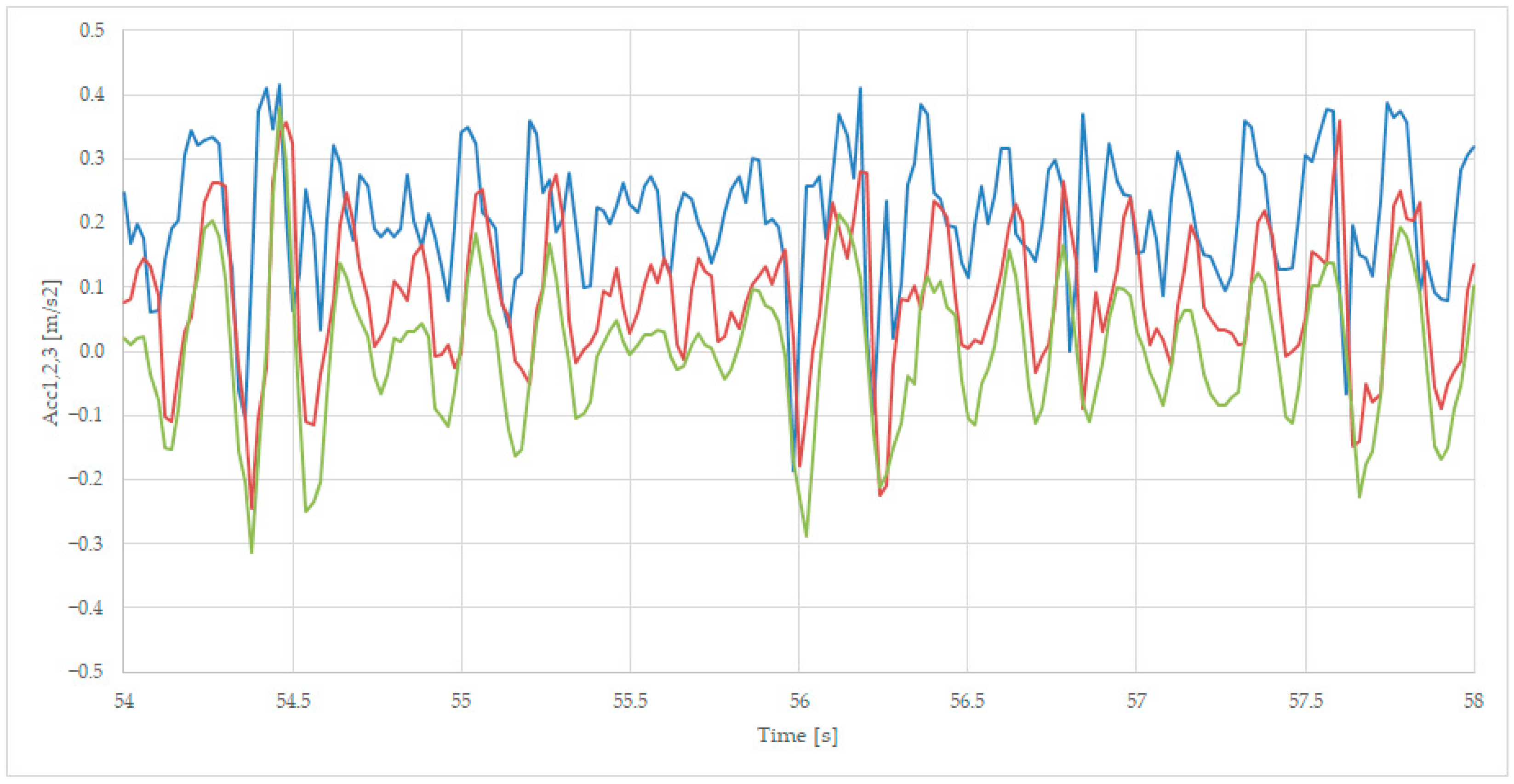
3.2. The Presentation of the Rough Data Saved during the Tests with the Loaded Wagon
3.2.1. Acceleration Measured at the Axle for the Loaded Wagon
3.2.2. Acceleration Measured on the First Bogie
3.2.3. Acceleration Measured on the Second Bogie
3.2.4. Interpretation of the Measurements
3.3. General Considerations about the Acceleration’s Values
4. Discussion
5. Conclusions
Author Contributions
Funding
Institutional Review Board Statement
Informed Consent Statement
Data Availability Statement
Conflicts of Interest
References
- Sebesan, I.; Mazilu, T. Vibrations of the Railway Vehicles; MatrixRom: Bucharest, Romania, 2010. (In Romanian) [Google Scholar]
- Dumitriu, M. Analysis of the dynamic response in the railway vehicles to the track vertical irregularities. Part I: The numerical analysis. J. Eng. Sci. Technol. Rev. 2015, 8, 24–31. [Google Scholar] [CrossRef]
- Dumitriu, M. Analysis of the dynamic response in the railway vehicles to the track vertical irregularities. Part II: The numerical analysis. J. Eng. Sci. Technol. Rev. 2015, 8, 32–39. [Google Scholar] [CrossRef]
- Mazilu, T. On the dynamic effects of wheel running on discretely supported rail. Proc. Rom. Acad.-Ser. A 2009, 10, 269–276. [Google Scholar]
- Young, T.H.; Li, C.Y. Vertical vibration analysis of vehicle/imperfect track systems. Veh. Syst. Dyn. 2003, 40, 329–349. [Google Scholar] [CrossRef]
- Manea, I.; Popa, G.; Ghiţă, G.; Prenta, G. Applying the Experimental Modal Analysis to Validate The Railway Frame Bogie Design. Proc. Rom. Acad. Ser. A 2016, 17, 48–56. [Google Scholar]
- Pombo, J.; Ambrósio, J. An alternative method to include track irregularities in railway vehicle dynamic analyses. Nonlinear Dyn. 2012, 68, 161–176. [Google Scholar] [CrossRef]
- Claus, H.; Schiehlen, W. Modelling and simulation of railway bogie structural vibrations. Veh. Syst. Dyn. 1998, 28, 538–552. [Google Scholar] [CrossRef]
- Schupp, G. Simulation of railway vehicles: Necessities and applications. Mech.-Based Des. Struct. Mach. 2003, 31, 297–314. [Google Scholar] [CrossRef]
- Eickhoff, B.M.; Evans, J.R.; Minnis, A.J. A review of modeling methods for railway vehicle suspension components. Veh. Syst. Dyn. 1995, 24, 469–496. [Google Scholar] [CrossRef]
- Cheli, F.; Corradi, R. On rail vehicle vibrations induced by track unevenness: Analysis of the excitation mechanism. J. Sound Vib. 2011, 330, 3744–3765. [Google Scholar] [CrossRef]
- Dumitriu, M.; Fologea, D. Numerical analysis on the correlation between bogie dynamic response and vertical track irregularities. UPB Sci. Bull. Ser. D Mech. Eng. 2019, 81, 99–110. [Google Scholar]
- Shan, W.; Wu, P.; Wu, X.; Zhang, F.; Shi, H. Effect of wheel polygonization on the axle box vibrating and bolt self-loosening of high-speed trains. J. Phys. Conf. Ser. 2019, 1213, 052044. [Google Scholar] [CrossRef]
- Darvishgohari, H.; Zarastvand, M.; Talebitooti, R.; Shahbazi, R. Hybrid control technique for vibroacoustic performance analysis of a smart doubly curved sandwich structure considering sensor and actuator layers. J. Sandw. Struct. Mater. 2021, 23, 1453–1480. [Google Scholar] [CrossRef]
- Gohari, H.D.; Zarastvand, M.R.; Talebitooti, R.; Loghmani, A.; Omidpanah, M. Radiated sound control from a smart cylinder subjected to piezoelectric uncertainties based on sliding mode technique using self-adjusting boundary layer. Aerosp. Sci. Technol. 2020, 106, 106141. [Google Scholar] [CrossRef]
- Agh, C. Comparative analysis of axle box acceleration in correlation with track geometry irregularities. Acta Tech. Jaurinensis 2019, 12, 161–177. [Google Scholar] [CrossRef][Green Version]
- Lee, J.E.; Naguib, H. Hybrid piezoelectric-magnetic, self-sensing actuator for vibration damping. In Proc. SPIE 12485, Nano-, Bio-, Info-Tech Sensors, and Wearable Systems; SPIE: Bellingham, WA, USA, 2023; p. 124850C. [Google Scholar] [CrossRef]
- Xu, L.; Zhai, W.; Gao, J. A probabilistic model for tracking random irregularities in vehicle/track coupled dynamics. Appl. Math. Model. 2017, 51, 145–158. [Google Scholar] [CrossRef]
- Boyang, A.; Wang, P.J.; Xu Chen, R.; Cui, D. Observation and simulation of axle box acceleration in the presence of rail weld in high-speed railway. Appl. Sci. 2017, 7, 1259. [Google Scholar] [CrossRef]
- Karis, T.; Berg, M.; Stichel, S. Analysing the correlation between vehicle responses and track irregularities using dynamic simulations and measurements. Proc. Inst. Mech. Eng. Part F J. Rail Rapid Transit 2020, 234, 170–182. [Google Scholar] [CrossRef]
- Dumitriu, M.; Racanel, I.R. Experimental verification of method to synthesize the track vertical irregularities. Rom. J. Transp. Infrastruct. 2018, 7, 40–60. [Google Scholar] [CrossRef]
- Karis, T.; Berg, M.; Stichel, S.; Li, M.; Thomas, D.; Dirks, B. Correlation of track irregularities and vehicle responses based on measured data. IJVMM-Veh. Syst. Dyn. 2018, 56, 967–981. [Google Scholar] [CrossRef]
- Diana, G.; Cheli, F.; Collina, A.; Corradi, R.; Melzi, S. The development of a numerical model for railway vehicles comfort assessment through comparison with experimental measurements. Veh. Syst. Dyn. 2002, 38, 165–183. [Google Scholar] [CrossRef]
- Oliveira, R.H.; Loprencipe, G.; Almeida Filho, F.G.; Sousa Pissardini, R. Experimental investigation on the use of multiple very low-cost inertial-based devices for comfort assessment and rail track monitoring. Measurement 2022, 199, 111549. [Google Scholar] [CrossRef]
- Test Ring of AFER, Faurei, Romania. Available online: http://www.afer.ro/ctff/ctff-en.html (accessed on 15 September 2023).
- BS EN 14363:2016+A2:2022; Railway Applications. Testing and Simulation for the Acceptance of Running Characteristics of Railway Vehicles. Available online: https://www.en-standard.eu/bs-en-14363-2016-a2-2022-railway-applications-testing-and-simulation-for-the-acceptance-of-running-characteristics-of-railway-vehicles-running-behaviour-and-stationary-tests/ (accessed on 20 September 2023).
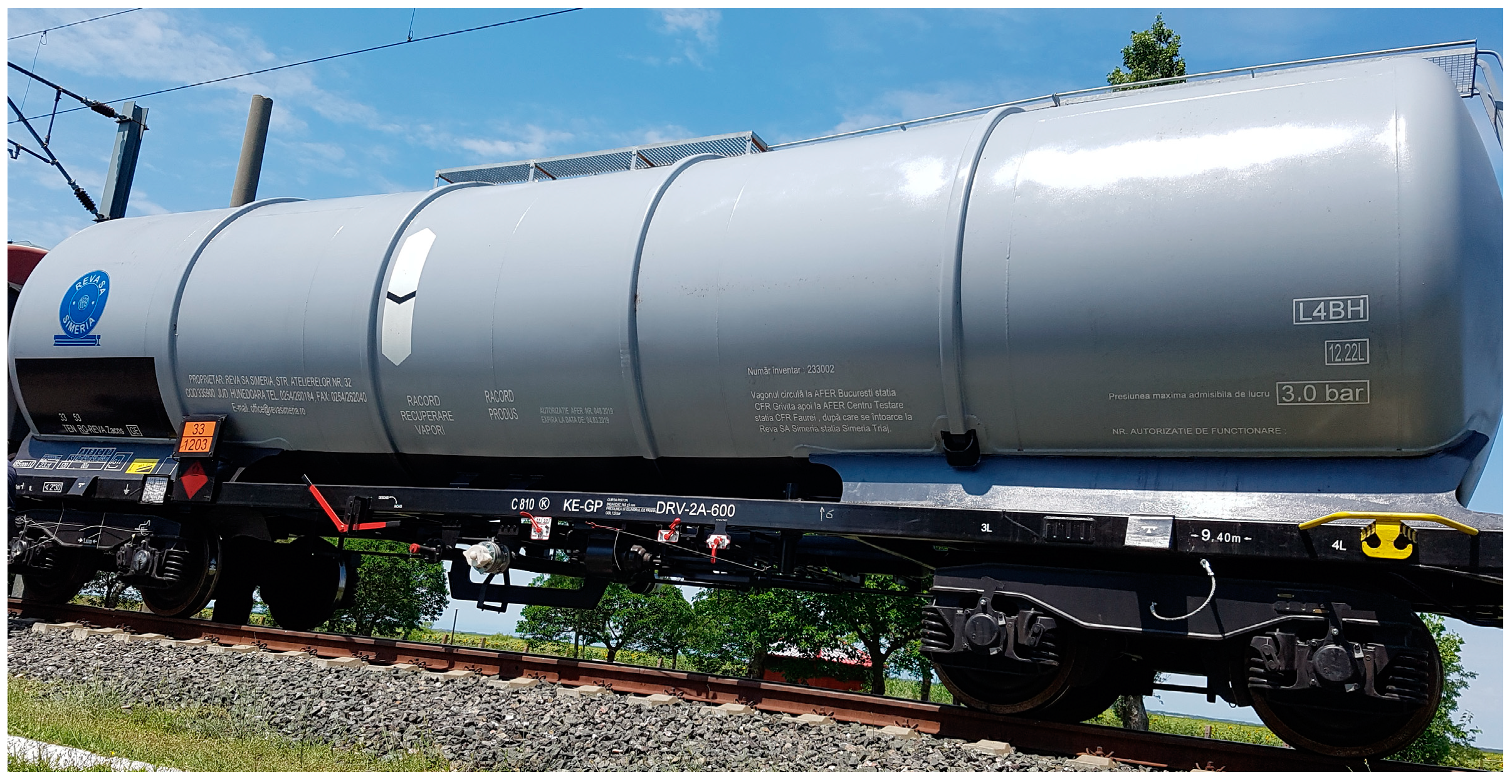
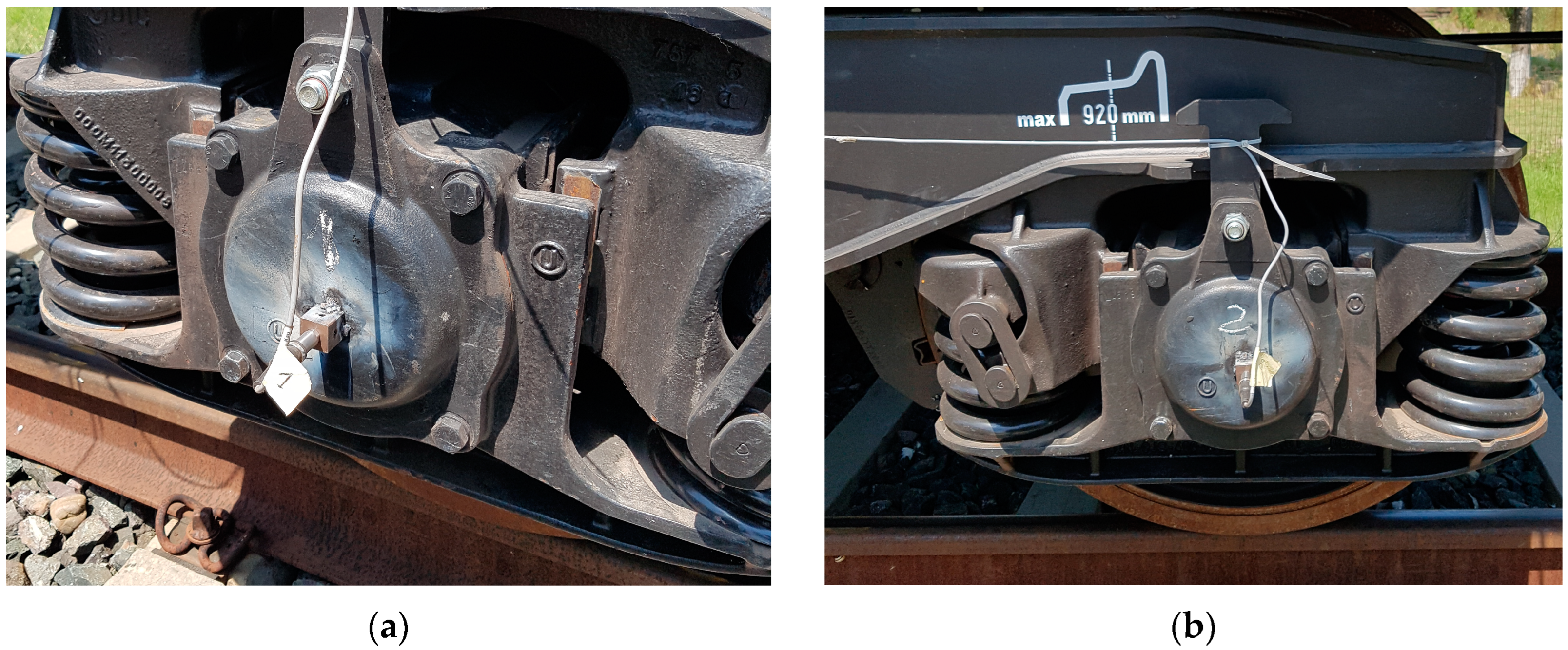

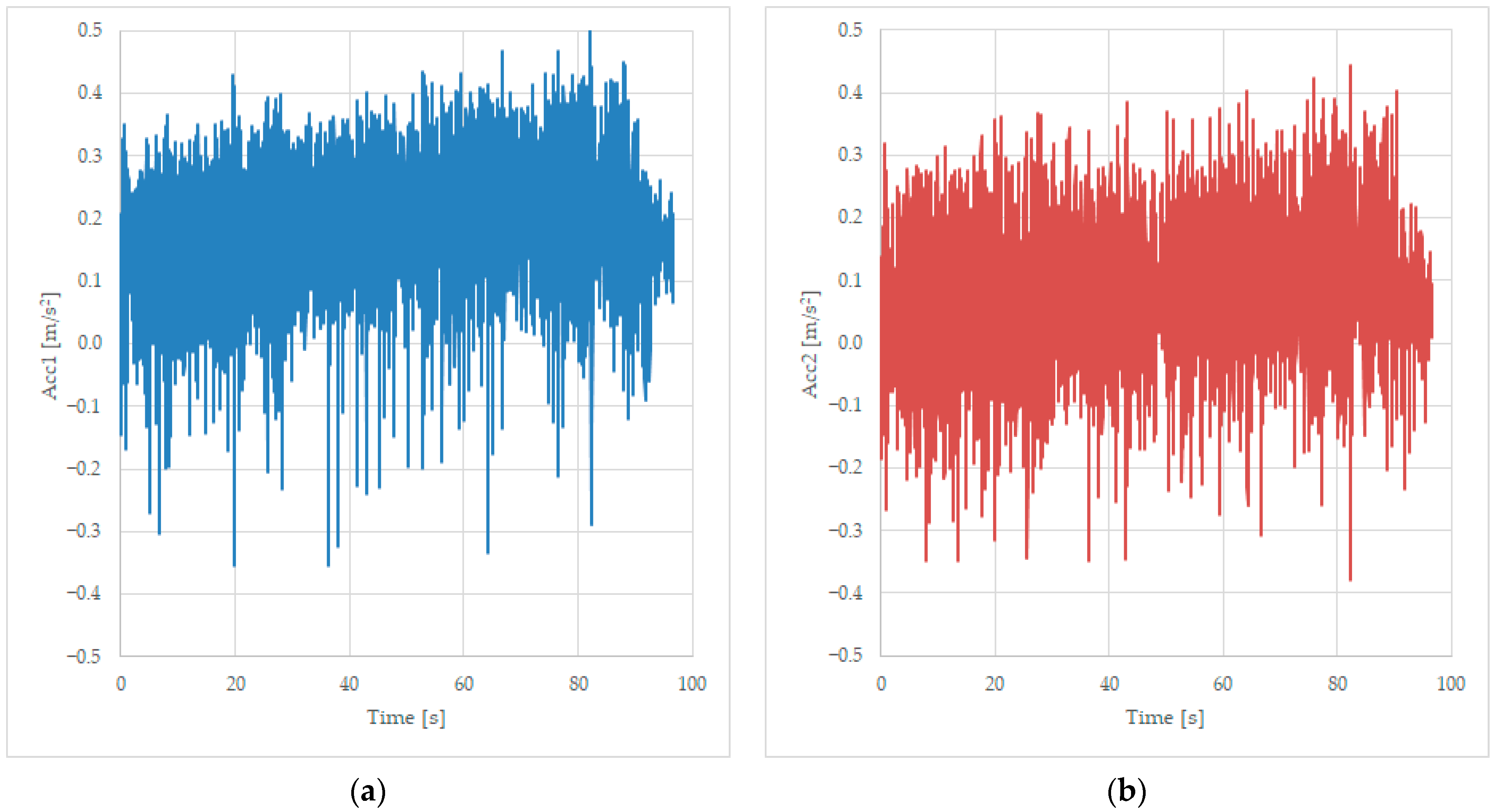

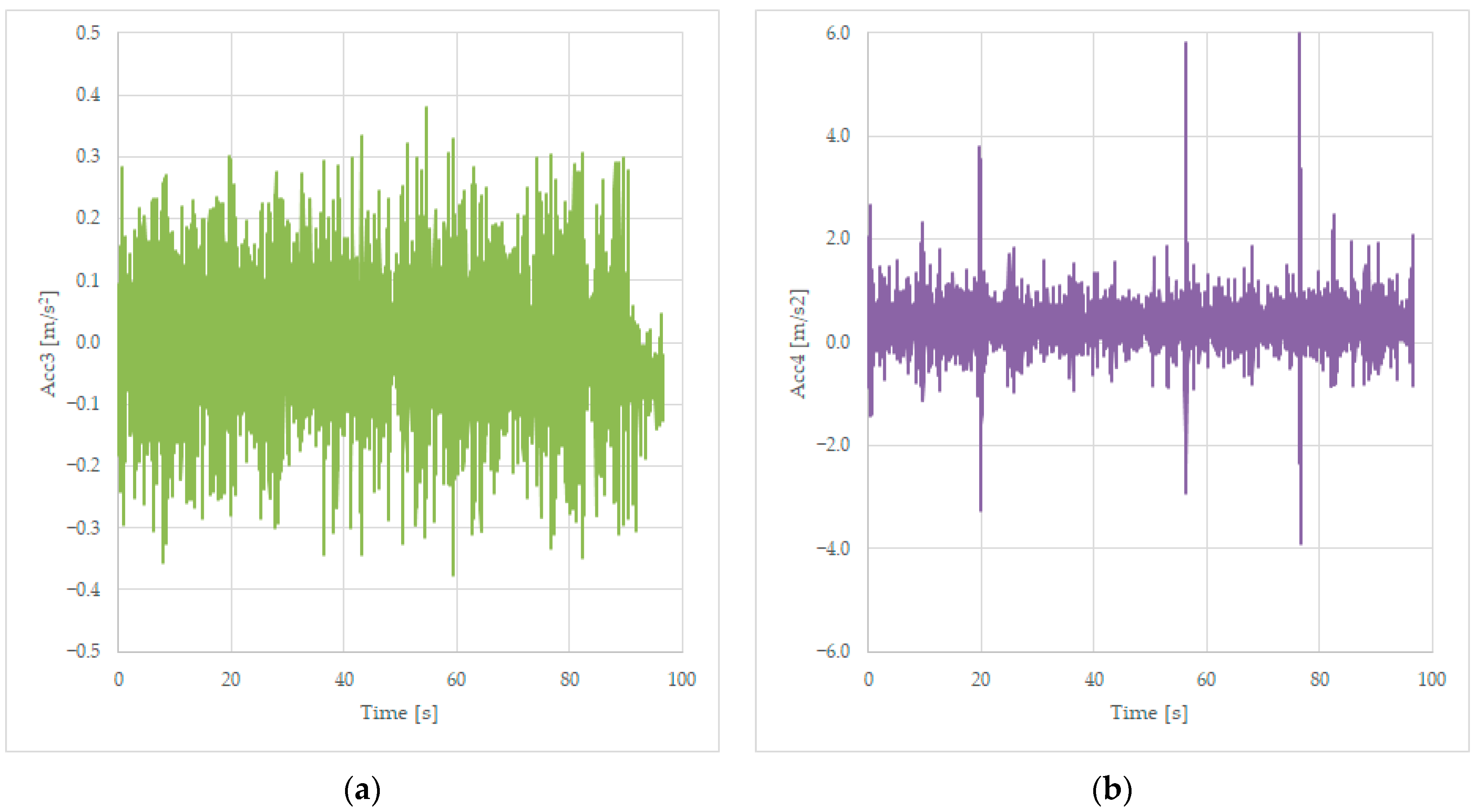





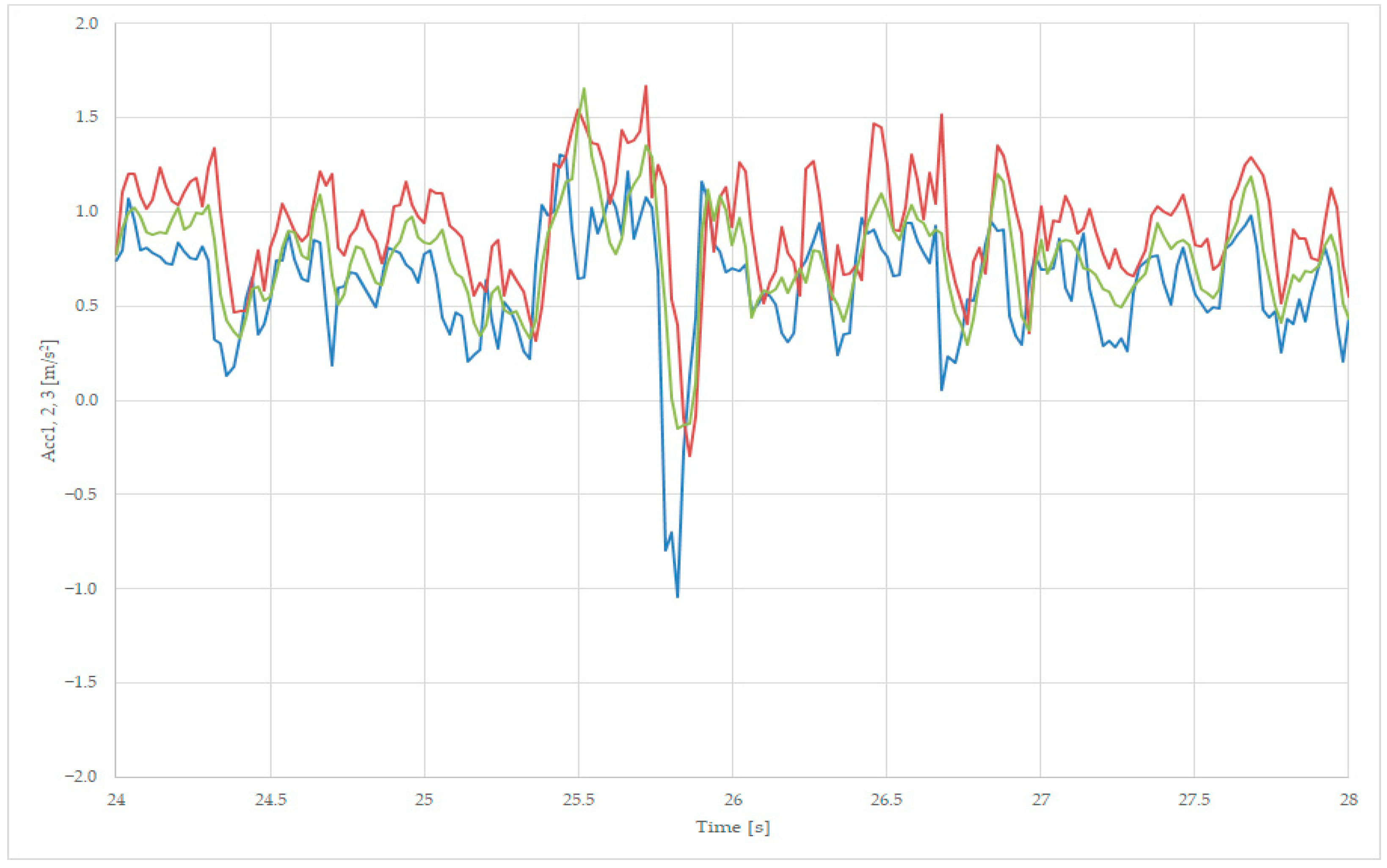
| Characteristics | Values | Units |
|---|---|---|
| Weight | 17 | grams |
| Nominal acceleration | +/−1000 | m/s2 |
| Voltage sensitivity | 0.4 +/− 5% | mV/ms−2 |
| Frequency range | 0.1 to 250 | Hz |
| Bias voltage | 2.5 | V |
| Power supply—constant voltage | 1 to 6 | V |
| Dimensions (excl. connector) | 13 × 13 × 40 | mm |
| Polarity: positive for acceleration in the longitudinal direction |
| Characteristics | Values | Units |
|---|---|---|
| Sampling rates | 19.2 | kS/s |
| Channels | 16 | |
| Accuracy class | 0.03 | |
| Input for voltage measurement | +/−10.2 | V |
| Response time (with filters) | 1 | ms |
| Input for current measurement | +/−20 | mA |
| Max. measurement frequency range | 2400 | Hz |
| Time | Acc1 | Acc2 | Acc3 | Acc4 | Acc5 | Acc6 |
|---|---|---|---|---|---|---|
| [s] | [m/s2] | [m/s2] | [m/s2] | [m/s2] | [m/s2] | [m/s2] |
| 0.00 | 0.87 | 1.14 | 0.89 | −0.07 | 0.60 | −0.75 |
| 0.02 | 0.77 | 1.14 | 0.91 | −0.09 | 0.58 | −0.66 |
| 0.04 | 0.64 | 1.22 | 0.93 | −0.03 | 0.46 | −0.47 |
| 0.06 | 0.66 | 1.17 | 0.94 | 0.01 | 0.44 | −0.21 |
| 0.08 | 0.83 | 1.18 | 1.04 | −0.04 | 0.57 | 0.10 |
| 0.10 | 0.85 | 1.31 | 1.04 | 0.07 | 0.61 | 0.19 |
| 0.12 | 0.83 | 1.17 | 0.99 | 0.18 | 0.68 | 0.24 |
| 0.14 | 0.81 | 1.24 | 1.03 | 0.14 | 0.75 | 0.04 |
| 0.16 | 0.78 | 1.11 | 1.01 | 0.21 | 0.78 | −0.36 |
| 0.18 | 0.75 | 1.12 | 0.94 | 0.13 | 0.77 | −0.52 |
| Type | Acc1 | Acc2 | Acc3 | Acc4 | Acc5 | Acc6 |
|---|---|---|---|---|---|---|
| Average | 0.189 | 0.071 | −0.002 | 0.364 | 0.105 | −1.780 |
| RMS | 0.218 | 0.139 | 0.114 | 0.613 | 0.402 | 1.781 |
| Min. | −0.353 | −0.378 | −0.374 | −3.885 | −1.405 | −2.433 |
| Max. | 0.532 | 0.444 | 0.379 | 5.987 | 1.440 | −0.920 |
| Type | Acc1 | Acc2 | Acc3 | Acc4 | Acc5 | Acc6 |
|---|---|---|---|---|---|---|
| Average | 0.635 | 0.884 | 0.723 | 0.105 | 0.459 | −0.472 |
| RMS | 0.678 | 0.918 | 0.758 | 0.346 | 0.509 | 0.561 |
| Min. | −1.042 | −0.293 | −0.243 | −2.700 | −0.390 | −3.412 |
| Max. | 1.462 | 1.705 | 1.658 | 3.695 | 1.277 | 3.135 |
Disclaimer/Publisher’s Note: The statements, opinions and data contained in all publications are solely those of the individual author(s) and contributor(s) and not of MDPI and/or the editor(s). MDPI and/or the editor(s) disclaim responsibility for any injury to people or property resulting from any ideas, methods, instructions or products referred to in the content. |
© 2023 by the authors. Licensee MDPI, Basel, Switzerland. This article is an open access article distributed under the terms and conditions of the Creative Commons Attribution (CC BY) license (https://creativecommons.org/licenses/by/4.0/).
Share and Cite
Mihăilescu, I.; Popa, G.; Tudor, E.; Vasile, I.; Gheți, M.A. Experimental Study of Wheel-to-Rail Interaction Using Acceleration Sensors for Continuous Rail Transport Comfort Evaluation. Sensors 2023, 23, 8064. https://doi.org/10.3390/s23198064
Mihăilescu I, Popa G, Tudor E, Vasile I, Gheți MA. Experimental Study of Wheel-to-Rail Interaction Using Acceleration Sensors for Continuous Rail Transport Comfort Evaluation. Sensors. 2023; 23(19):8064. https://doi.org/10.3390/s23198064
Chicago/Turabian StyleMihăilescu, Ioana, Gabriel Popa, Emil Tudor, Ionuț Vasile, and Marius Alin Gheți. 2023. "Experimental Study of Wheel-to-Rail Interaction Using Acceleration Sensors for Continuous Rail Transport Comfort Evaluation" Sensors 23, no. 19: 8064. https://doi.org/10.3390/s23198064
APA StyleMihăilescu, I., Popa, G., Tudor, E., Vasile, I., & Gheți, M. A. (2023). Experimental Study of Wheel-to-Rail Interaction Using Acceleration Sensors for Continuous Rail Transport Comfort Evaluation. Sensors, 23(19), 8064. https://doi.org/10.3390/s23198064






